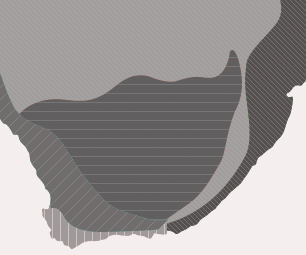Aloe saundersiae
Aloe saundersiae (Reynolds) Reynolds
Family: Asphodelaceae
Common names: Nkandla grass aloe, Saunders’ grass aloe, dwarf grass aloe (Eng.); Nkandla-grasaalwyn (Afr.).
Introduction
Aloe saundersiae is among the smallest aloes of the world, with ascending spreading, linear leaves from a central rosette and small pinkish white flowers in small heads in late summer. It grows on shallow sandstone bedrock among grass and is very difficult to discern in its sunny grassland habitat, even when in flower. Easily propagated from division or seed.

Fig. 1. Aloe saundersiae in flower in its native grassland habitat near Nkandla Forest, KwaZulu-Natal, growing on shallow bedrock among moss and grass, and a close-up of the flowers.
Description
Description
Aloe saundersiae is a solitary or cluster-forming, very short-stemmed, dwarf perennial. The roots are fleshy, fusiform. Leaves, 10–16, in a rosette, 50–75 mm high. The leaves are soft, flaccid, linear, 40–80 × 3 mm, spreading or recurved, amplexicaul at the base, here up to 10 mm in diameter; upper surface slightly canaliculate, green, without spots, the lower surface convex, with few, scattered spots near the base; margins dentate, teeth soft, 0.5 mm long.

Fig. 2. Close up of the leaf rosette of an Aloe saundersiae in its native habitat, growing among moss, Nkandla, KwaZulu-Natal.
Inflorescence unbranched, up to 180 mm tall; raceme capitate, up to 25 mm long, bearing up to 16 flowers. Flowers cylindric-trigonous, up to 12 mm long, slightly swollen at the base, slightly bent towards the throat, pale creamy pink; mouth triangular; pedicels up to 10 mm long. Capsule small, seeds grey-black. Aloe saundersiae flowers in summer (February–March).

Fig. 3. Close-up of the leaves of a dense intertwined cluster of Aloe saundersiae in its natural habitat near Nkandla Forest, KwaZulu-Natal.
Conservation Status
Status
Aloe saundersiae is assessed as Endangered (EN) by the Red List of South African Plants, due to its limited distribution, small and fragmented population and the fact the region is grazed and experiences frequent fires. Although plants are co-adapted to grazing, and fire is a natural driving force in the local grasslands, overgrazing, trampling and too-frequent fires is causing soil erosion and degrading the habitat and has resulted in a sharp decline in the number of plants, which is ongoing.

Fig. 4 The habitat of Aloe saundersiae, near Nkandla Forest, grassland on mineral poor quarzitic sandstone soil, KwaZulu-Natal, South Africa.
Distribution and habitat
Distribution description
Aloe saundersiae has a limited distribution in the KwaZulu-Natal midlands and is known only from the area between Melmoth, Nkandla, Greytown and Wartbug, growing at altitudes of 1 000–1 500 m. Its grassland habitat (Northern Zululand Sourveld, KwaZulu-Natal Sandstone Sourveld, Midlands Mistbelt Grassland and Moist Coast Hinterland Grassland) is frequently covered in fog. Plants grow scattered among grass tufts or moss, among rocks and in crevices, in mistbelt and moist grassland, and are very difficult to detect. Rainfall is substantial, ranging from 1 500–1 750 mm per annum, and is experienced mainly in summer. The average daily maximum temperature is about 20°C and the average daily minimum about 8°C. Plants are annually burnt during veld fires, but resprout in spring.
The plants were observed near Nkandla growing among mineral-poor quarzitic sandstone rocks in grassland, in hilly terrain, on all apects. They grow among grass and moss. Other succulents observed in its habitat, include Aloe arborescens, Coleus hadiensis, Crassula pellucida subsp. alsinoides, Crassula perfoliata and Boophone disticha.

Fig. 5. A flowering cluster of Aloe saundersiae in a rock crevice, near Nkandla Forest, growing with Crassula perfoliata.
Derivation of name and historical aspects
History
Aloe saundersiae honours Lady Katharine Saunders (née Wheelwright) (1824–1901), botanical artist and plant collector. The plant was collected by her son Charles Saunders (1857–1935) in February 1931, near Nkandla Forest. Aloe saundersiae was named by Gilbert Reynolds as Leptoaloe saundersiae in 1936, but he transferred it to the genus Aloe in 1947. Aloe saundersiae has little horticultural appeal and is merely a collector’s item. It is distinct from A. liliputana, the smallest of the South African Aloe species.
Aloe saundersiae belongs in the Graminialoe, named by Reynolds, with 7 other species: Aloe albida, A. liliputana, A. modesta, A. inconspicua, A. minima, A. parviflora and A. myriacantha, all of them confined to grassland vegetation. It is closely related to Aloe liliputana from Pondoland, but the rosettes are larger and more robust and the plant is cluster-forming whereas Aloe liliputana is a solitary aloe and does not form offsets.

Fig. 6. Close up of an Aloe saundersiae leaf rosette in its native habitat, growing among moss, Nkandla, KwaZulu-Natal.
Ecology
Ecology
Aloe saundersiae grows in full sun in grassland, in mineral-poor quarzitic sandstone among tufts of grass and often on bedrock. Moisture is stored in the fusiform roots and leaves, which enables the plant to survive the dry winters. During dry conditions the plants become reddish due to anthocyanin pigments, which slow the process of photosynthesis. Its well camouflaged nature enables the plant to blend in with the grassy vegetation, and, in fact when it is not in flower it is almost impossible to see, thus escaping predation. The local grassland vegetation is grazed by cattle and there is evidence of annual to biannual fires during the dry winter months. The firmly rooted plants will not be damaged by grazing and this little dwarf simply re-sprouts after a fire, thus well adapted to natural disturbances. The growing season is from spring to autumn and the flowers pollinated by insects. The fruiting capsule, as with other aloes, are held in an erect position and when mature open from the top, requiring gusts of wind to disperse the seeds.

Fig. 7. A cluster of Aloe saundersiae plants, growing on shallow quarzitic sandstone rock near Nkandla Forest, showing signs of stress, note the reddish leaves.
Uses
Use
Other than its ornamental use, no other uses have been recorded.
Growing Aloe saundersiae
Grow
Aloe saundersiae is best grown in cool, Afro-alpine or summer-rainfall, grassland gardens in slightly acidic, mineral-poor, peaty soils. Feed regularly in spring and summer. It is very small and is best kept as a container subject. It thrives in a greenhouse and must be kept moist and cool during the summer months. Plants are prolific from the base, soon becoming cluster-forming. Seeds germinate within three weeks, and plants are fast growing and can flower in their second year. The soft leaves and stems are prone to snail attack.
Occasionally propagated and cultivated and grown in collections. This is more a collector’s item. Plants can be fed with a diluted organic fertilizer. It can be grown in full sun or dappled shade. Plants need protection in regions where frost is a problem. Propagation is from division or seed. Sow seed in spring in a shallow tray in a medium of 2 parts sand and 1 part well broken down compost. Keep moist and germination should occur within 3 weeks. Keep seedlings moist until big enough to handle, when they can be planted out into individual containers.
Vegetative propagation is also achieved by dividing plants which form clusters. Root in sand. Best to achieve this during spring or summer. Keep moist until well rooted.
References
- Craib, C. 2005. The grass aloes of the South African veld. Umdaus Press, Hatfield, Pretoria.
- Germishuizen, G. & Meyer, N.L. (eds) 2003. Plants of southern Africa: an annotated checklist. Strelitzia 14. National Botanical Institute, Pretoria.
- Mtshali, H., Scott-Shaw, C.R., Church, B. & Von Staden, L. 2018. Aloe saundersiae (Reynolds) Reynolds. National Assessment: Red List of South African Plants. https://redlist.sanbi.org/species.php?species=2206-228.
- Mucina, L. & Rutherford, M.C. (eds) 2006. The vegetation of South Africa, Lesotho and Swaziland. Strelitzia 19. South African National Biodiversity Institute, Pretoria.
- Reynolds, G.W. 1950. The aloes of South Africa. Trustees of the Aloes of South Africa Book Fund, Johannesburg.
- Van Wyk, A.E. & Smith, G.F. 2001. Regions of floristic endemism in South Africa. A review with emphasis on succulents. Umdaus Press, Hatfield, Pretoria
- Van Jaarsveld, E.J. & Harrower, A. 2014. Aloe liliputana, a new grass aloe from Pondoland, Eastern Cape, Republic of South Africa. Bradleya 32:30–35.
Credits
Ernst van Jaarsveld
Kirstenbosch National Botanical Garden (Retired)
Babylonstoren Farm (Current)
Extraordinary senior lecturer and researcher,
Department of Biodiversity and Conservation, University of the Western Cape
June 2025
Plant Attributes:
Plant Type: Succulent
SA Distribution: KwaZulu-Natal
Soil type: Sandy
Flowering season: Late Summer
PH: Acid
Flower colour: White, Pink, Cream
Aspect: Full Sun, Morning Sun (Semi Shade), Afternoon Sun (Semi Shade)
Gardening skill: Challenging
Special Features:
Horticultural zones







Rate this article
Article well written and informative
Rate this plant
Is this an interesting plant?
Login to add your Comment
Back to topNot registered yet? Click here to register.